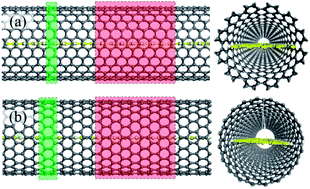Emergent properties and trends of a new class of carbon nanocomposites: graphenenanoribbons encapsulated in a carbon nanotube†
Abstract
Using density functional theory calculations, we show that recently synthesized carbon nanocomposites of

* Corresponding authors
a
Bremen Center for Computational Materials Science, University of Bremen, Am Falturm 1, Bremen, Germany
E-mail:
kouliangzhi@gmail.com
b Department of Physics and Astronomy and High Pressure Science and Engineering Center, University of Nevada, Las Vegas, Nevada 89154, USA
c School of Engineering, University of California, Merced, CA 95343, USA
d Institute for Theoretical Physics, University of Bremen, Otto-Hahn-Allee 1, 28359 Bremen, Germany
Using density functional theory calculations, we show that recently synthesized carbon nanocomposites of

 Please wait while we load your content...
Something went wrong. Try again?
Please wait while we load your content...
Something went wrong. Try again?
L. Kou, C. Tang, T. Wehling, T. Frauenheim and C. Chen, Nanoscale, 2013, 5, 3306 DOI: 10.1039/C3NR33941F
To request permission to reproduce material from this article, please go to the Copyright Clearance Center request page.
If you are an author contributing to an RSC publication, you do not need to request permission provided correct acknowledgement is given.
If you are the author of this article, you do not need to request permission to reproduce figures and diagrams provided correct acknowledgement is given. If you want to reproduce the whole article in a third-party publication (excluding your thesis/dissertation for which permission is not required) please go to the Copyright Clearance Center request page.
Read more about how to correctly acknowledge RSC content.
 Fetching data from CrossRef.
Fetching data from CrossRef.
This may take some time to load.
Loading related content
